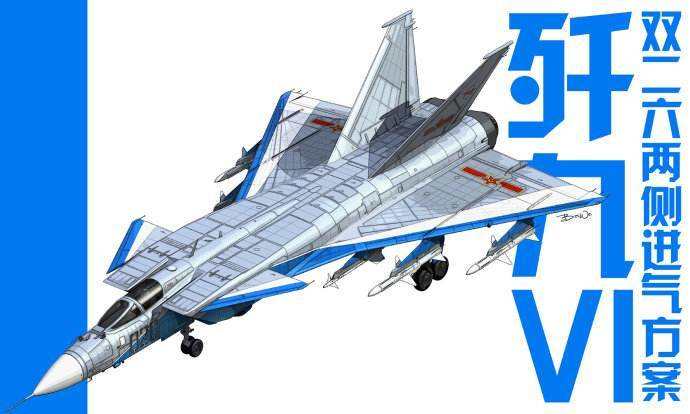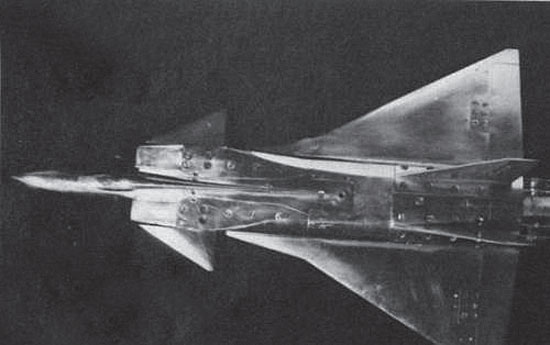| Jian-9(J-9)Fighter aircraft
中国歼-9(J-9)战斗机 Date:2020-04-05 Source:Globalsecurity By:Globalmil Viewed: |

The J-9 designation was apparently initially applied to an unbuilt single engine development of the J-8 aircraft that was cancelled in development around 1979. Nikolai Cherikov ["The Shenyang F-9 Combat Aircraft" Interavia, vol. 31, Dec. 1976, pp. 1160-1162] reported that China began the development of its own combat aircraft, designated the F-9, after the final break with the Soviet Union at the beginning of the 1960s. The design of the F-9 was largely based on that of the Soviet MiG-19, which had been constructed in China under license. The F-9 was to be given an all-weather capability. Various modifications were made to improve aircraft performance and enhance its operational life. The development of the F-9 from the MiG-19 was viewed as an interim solution.
显然,最初将J-9命名应该是用于J-8飞机的未制造单发动机型号开发,该开发在1979年左右被取消。Nikolai Cherikov ["The Shenyang F-9 Combat Aircraft" Interavia, vol. 31, Dec. 1976, pp. 1160-1162] 报道说中国在1960年代初与苏联最终决裂之后,开始研制自己的战斗机,命名为F-9。 F-9的设计主要基于苏联米格-19(MiG-19)的设计,后者是中国在许可下制造的。F-9被赋予全天候能力。进行了各种修改以提高飞机性能并延长其使用寿命。米格-19的F-9研发被视为临时解决方案。
The F-9 FANTAN designation was at one time applied to the Q-5 FANTAN attack aircraft. Should the FC-1 enter PLAAF service, it might carry the J-9 designation.
F-9 FANTAN(北约代号Fantan“番摊”)称号同时应用于强-5型(Q-5) FANTAN攻击机。如果FC-1进入中国人民解放军空军(PLAAF)服役,则它可能命名为J-9。
The J-9, built by Chengdu Aircraft Corporation, never entered production. The single engine, delta canard design was cancelled in 1980, but the aerodynamic research in the program paved the way for the J-10 and J-20. The J-9 project was transferred from Shenyang to Chengdu in 1969. The design dates from the 1970s, and it could have been an impressive aircraft, for the time, had the required technology been available. The J-9's performance requirements were focused on beating the F-4 Phantom II in combat, which had emerged as the primary American fighter aircraft in Vietnam. It was intended to carry the the PL-4, the PLAAF's version of the Sparrow, which had an SARH and IR versions. This missile was cancelled in 1985 due to technical issues. Development of the J-9 was halted in 1980 in the wake of the inability to develop the high-performance engine needed for the aircraft. The Shenyang J-8 Finback and its developments ended up filling the role intended for the J-9 design. While the J-9 remained unbuilt, it laid the ground for Chengdu's later development of the J-10 fighter, which was also a canard delta planform.
由成都飞机公司制造的J-9从未投入生产。单发动机,鸭式三角翼设计在1980年被取消,但该计划中的空气动力学研究为J-10和J-20铺平了道路。J-9项目于1969年从沈阳移交到成都。设计始于1970年代,如果具备所需的技术,那它本来可以说是一架令人印象深刻的飞机。J-9的性能要求集中于在战斗中击败F-4 Phantom II,后者已成为美国在越南主要的战斗机。它打算携带PL-4,这是PLAAF的美制“麻雀”空对空导弹型号,具有半主动雷达制导(SARH)和红外制导(IR)型号。由于技术问题,该导弹于1985年被取消。由于无法开发飞机所需的高性能发动机,J-9的研制工作于1980年停止。沈阳J-8 Finback(北约代号Finback“长须鲸”)及其发展最终填补了J-9设计所要扮演的角色。虽然J-9仍未建造,但为成都后来的J-10战斗机的研发奠定了基础,这也是一个鸭式三角翼的计划。
Following early aerial combat over Vietnam in 1962-63, the PLAAF recognized that the range and performance at higher altitude of the J-6 and J-7 fighters [MiG-19 and MiG-21] were inadequate to counter American fighters. In October 1964 the development of a new fighter was initiated. Concept studies were initially based on evaluation of simulated dogfights using the J-7, which had a low combat radius, poor intercept speed, inadequate fire control radar, and dated aerodynamic characteristics.
在1962-63年越南上空的早期空战之后,中国人民解放军意识到J-6和J-7战斗机[MiG-19和MiG-21中国仿制型]在较高高空的航程和性能不足以对抗美国战斗机。1964年10月,开始研发新型战斗机。概念研究最初基于使用J-7进行的模拟混战的评估,这种战斗机的战斗半径小,拦截速度差,火控雷达不足以及过时的空气动力学性能。
The 601 Bureau in Shenyang began work on improving the J-7, with two possible development paths pursued in parallel:
1. The use of the J-7 as basis for an advanced twin-engined jet fighter. The general layout of the standard J-7 was to be retained without major changes. It would be powered by two improved versions of the WP-7 turbojet with thrust of 43-44 kN (4.4 klbst) each. This approach eventually led to the Shenyang J-8.
2. The development of a new single-engined fighter using a new turbofan engine (which was to be designed by the 606 Bureau) in the thrust class of 83-121 kN (8.5-12.4 klbst) with a new air intake configured to accommodate a suitable radar. The primary challenge with the second approach was China's lack of experience with a modern turbofan engine. Consequently, many engineers associated with this approach feared the development of the engine would hold back the development of the fighter, whichw as in fact what happened.
沈阳601所开始改进J-7的工作,并同时寻求两种可能的发展途径:
1.将J-7用作先进的双发喷气式战斗机的基础。标准J-7的总体布局应保持不变。它将由两台改进型的WP-7涡轮喷气发动机提供动力,每台推力为43-44 kN(4.4 klbst)。这种方法最终导致产生了沈阳J-8。
2.使用推力为83-121 kN(8.5-12.4 klbst)的新型涡扇发动机(由606所设计)开发新型单发战斗机,并配置新的进气口去容纳适合的雷达。第二种方法的主要挑战是中国缺乏现代化涡扇发动机的经验。因此,许多与这种方法相关的工程师担心发动机的发展会阻碍战斗机的发展,而实际上这是事实。
The initial goal of this two-fold development program was a an air superiority fighter in the 10-ton weight class with an operating altitude of 22,000 meters, a maximum speed of Mach 2.2 with a range of 1.600 km, in order to keep up with the performance of the American F-4 Phantom II. These goals were later expanded to "2 x 25" - Mach 2.5 at 25.000 meters.
这项双重发展计划的最初目标是,研制出重量为10吨的空中优势战斗机,其操作高度为22,000米,最大速度为2.2马赫,航程为1.600公里,为了赶上美国F-4 Phantom II的性能。这些目标后来扩大到“ 2 x 25”-在25.000米处达到2.5马赫。
The 601 Institute at Shenyang submitted four drafts during 1965, each of them with a different aerodynamic layout, such as wing configurations, leading-edge angles and the arrangement of the air intakes (ventral or lateral):
1. 50° delta wing (sweep wing)
2. 55° delta wing (sweep wing) with tailplane
3. 50° double delta wing
4. 57° delta-wing
沈阳601研究所在1965年提交了四份草图,每份草图具有不同的空气动力学布局,例如机翼配置,前缘角度和进气口的布置(侧面或侧面):
1. 50°三角翼(后掠翼)
2. 55°三角翼(后掠翼),带尾翼
3. 50°双三角翼
4. 57°三角翼
The initial concept was known as "draft A" ( J-9A) with the four different configurations. The J-9A-IV was similar in appearance to the later improved J-8B (J-8II) with a leading-edge angle of 55°. Further wind-tunnel tests in the fourth quarter of 1966 and early 1967 led to the conclusion that the agility of the new fighter was deficcient, as these configurations were unstable at certain airspeeds. This led to the concept designated "draft B" (J-9B), or configuration V, with a full delta configuration J-9B-V. But this also produced problems with lift at certain airspeeds and complicated the placement of lift control devices. The J-9B-V was tailless delta, similar to the contemporary Mirage III, with a leading-edge angle of 60° and a wing surface of 62 m2.
最初的概念被称为“草案A”(J-9A),具有四种不同的配置。J-9A-IV的外观与后来改进的J-8B(J-8II)相似,前角为55°。1966年第四季度和1967年初进行了进一步的风洞测试,得出的结论是,新战斗机的敏捷性不足,因为这些配置在某些空速下不稳定。这导致了称为“草稿B”(J-9B)或配置V的概念,具有完整的增量配置J-9B-V。但这也会在某些空速下产生升力问题,并使升力控制装置的安排复杂化。J-9B-V是无尾三角翼,类似于当代的幻影Ⅲ(Mirage III),前缘角为60°,机翼表面为62 m2。
By this time the Great Proletarian Cultural Revolution impacted the program, and the development and construction of the J-9 Project was completely stopped by March 1968. After a further conference it was decided to resume work on the J-9B-V in 1969, with the goal to achieve the first flight to 20th anniversary of the People's Republic of China on 01 October 1969. Supporting that decision were conclusions drawn from the Vietnam War and combat experience in the Middle East, which placed new demands on the PLA Air Force.
那时,文革对该计划产生了影响,J-9项目的开发和制造在1968年3月之前完全停止了。在进一步的会议之后,决定在1969年恢复J-9B-V的工作,其目标是在1969年10月1日中华人民共和国建国20周年实现首次飞行。支持该决定的是越南战争和中东战争经验得出的结论,这对解放军空军提出了新的要求。
In order to make it possible for Shenyang to concentrate parallel on the further development and manufacturing of the J-8 it was decided to shift responsibility for production from Plant 112 to Plant 132 Chengdu Aviation Company. The Ministry of Defense once again changed the performance requirements to: "good agility" / combat radius 900-1000 km / maximum weight 13 tons / load factor of +9 g / service ceiling of 25,000 meters and maximum speed of Mach 2.5 (the "double-25-requirement") and later to the "double-26-requirement": Mach 2.6 at 26,000 m.
为了使沈阳能够集中精力进行J-8的进一步开发和制造,决定将生产责任从第112工厂转移到第132工厂成都飞机制造厂。国防部再次将性能要求更改为:“良好的敏捷性” /作战半径900-1000 km /最大重量13吨/负载系数+9 g /实用升限25,000米,最大速度为2.5马赫(“ double-25要求”),后来又到了“ double-26要求”:26,000米处为2.6马赫。
This required a return to the draft J-9B-V again and development further to the draft J-9B2 or now called J-9B-VI. It was decided to continue the development of the "new" J-9 as a delta-canard with either one ventral or two lateral air intakes. Possibly this study with the single ventral air intake formed the basis of the subsequent Chengdu J-10A.
这要求再次返回J-9B-V草案,并进一步发展到J-9B2草案或现在称为J-9B-VI的草案。决定继续开发具有三角翼的“新” J-9,该三角翼具有一个腹部进气口或两个侧向进气口。这项研究可能与单个腹部进气口一起构成了随后的成都J-10A的基础。
As had happened so often since the start of the program, this design was abandoned as the requirements were much too ambitious and the continuing problems with the planned WS-9 turbofan couldn't be resolved. On 18 February 1975 the "Central Military Committee" formulated a resolution for a development program consisting of a test series of 5 machines with a first flight around 1980/81, leading to the start of mass production in 1983. At the beginning 1976 the final layout of the J-9 in the version J-9B-VI was specified briefly: delta-canard-layout with a 60° leading edge sweep, 50m2 wing area, canard wings with 55° leading edge sweep and each 2,85m2 area, as well as two lateral air intakes. The inlets would be equipped with variable inlets providing a Type-910 turbofan engine with a thrust of 12.4 klbst with afterburner. One Type-205 multi-mode radar with a maximum search range of 60-70 km and a pursuit range of 45-52 km for the new PL-4 medium-range missile was intended.
自从计划开始以来经常发生这种情况,该设计被放弃了,因为要求过于雄心勃勃,而且计划中持续的问题WS-9涡扇发动机无法解决。1975年2月18日,“中央军事委员会”制定了一项开发计划的决议,该决议由5架样机系列试验组成,首次飞行于1980/81年左右,并于1983年开始批量生产。1976年初,最终简要详列了J-9B-VI版本中J-9的布局:前掠角为60°,机翼面积为50m2的三角翼布局,前掠角为55°且每个面积为2,85m2的鸭翼,以及两个侧面进气口。进气口将配备可变进气口,从而由910型涡扇发动机提供推力,其推力为12.4 klbst(加力燃烧器)。一部新型205型多模雷达最大搜索范围为60-70 km,跟踪范围为45-52 km用于计划中的新型PL-4中程导弹。
In 1978 the priority of the J-9 program was scaled back once again. Some sources assume that still unresolved technical problems existed, others suggested that the parallel development of the improved J-7III (= J-7C/D) and the Shenyang J-8B promised better chances of success and earlier in service dates. The result was in any case that the development of the Chengdu J-9 finally ended at the end of 1980.
1978年,J-9计划的优先级再次降低。 一些消息来源认为仍然存在尚未解决的技术问题,另一些消息来源则认为,改进型J-7III(= J-7C/D)和沈阳J-8B的并行开发有望获得更大的成功机会,并有更早的服役日期。结果无论如何,成都J-9的开发终于在1980年底结束了。
In the development of military aircraft, the choice of the engine is the key to the success of the machine. In the aviation development process around the world, too often engines clip the wings of combat aircraft. Because of the performanc of the new domestic AL-31 advanced turbofan enginee, use on the J-10 fighter, the flight performance is better than the earlier models.
在军用飞机的发展中,发动机的选择是机型成功的关键。在全世界的航空发展过程中,发动机经常会剪断战斗机的机翼。由于在J-10战斗机上使用新型国产AL-31先进涡扇发动机的性能,其飞行性能要优于早期机型。
补充资料:《中国歼击机性能之“最”:歼-9》节选 来源:光明网
1965年4月12日,三机部以三院字第585号文下达了《关于开展歼9歼击机方案论证和设计工作的通知》,要求在两个方面进行方案论证和比较。六院在具体部署中提出力争在6月拿出方案。六院一所根据以上通知精神,立即开始了方案论证工作,并按时提出了初步方案。方案一主要突出歼击性能,兼顾截击作战和对付低空高速目标,最大马赫数2.3左右,升限20000米左右,航程要大,作战半径大于450千米;方案二则主要突出截击性能,兼顾歼击作战,最大马赫数2.4~2.5,升限21~22千米,作战半径350千米。两个方案总重量要求控制在14吨左右。

歼-9风洞模型之一
1、910发动机也是我国第一次设计大推力发动机,其设计为双轴内外涵混合加力式涡扇发动机,设计最大推力70.6千牛,加力推力121.5千牛,推重比为6,在当时来说是一种性能十分先进的大推力发动机。当时中国已经从越南弄来了一些F-4的残骸,1964年9月在英国范堡罗航展上又把英国斯贝发动机的结构图抄了回来,这些重要的参考资料成为了910发动机的基础。910发动机于1964年10月开始进行初步设计。与此同时,航空工业对歼9的研制也作出了调整:1969年7月,中央成立航空工业领导小组,六院划归空军领导。同年8月召开航空工业会议,会上决定尽快搞出歼9飞机来。事后三机部军管会和六院军管会发出联合通知,重新作了部署,要求歼9飞机在1971年上天,力争提前,同时把试制工厂由320厂改为132厂。由此,才产生了成都的601分所。
2、1975年12月23日,国家计委、国务院国防工办以(75)工办字395号文批准三机部上报的歼9飞机研制实施计划。同意零批试制5架,1980年首架上天,1983年设计定型,并原则上同意到1983年拨给研制费4亿元。
3、歼9并没有因为项目的下马而彻底随风消逝。相反,611所对鸭式布局的研究为后来研制歼10打下了基础。在歼9的研制过程中,611所对鸭式布局的研究进行了近万次风洞试验,取得了大量的数据,编写了数十本研究报告。在经过3年对新型歼击机的摸索和与“10号工程”研制方案的反复比较后,终于被多数领导机关和领导人员所承认。20世纪80年代中期,国防科工委批复,确定新型歼击机研制总体单位定点在611研究所和132厂,新歼(即现在的歼10)设计工作由611研究所承担。可以这样认为:没有歼9的难产,也不会有歼10的出生。
上一篇:Shenyang J-31 下一篇:没有了
| Jian-9(J-9)Fighter aircraft
中国歼-9(J-9)战斗机 |
| The J-9 designation was apparently initially applied to an unbuilt single engine development of the J-8 aircraft that was cancelled in development around 1979. ... [2020-04-05] |
| Shenyang J-31
中国沈阳J-31型隐形战斗机 |
| The Shenyang J-31(or "FC-31 fifth Generation Multi-Purpose Medium Fighter") also known as the "Gyrfalcon" (鹘鹰), or "Falcon Hawk" by some military enthusiasts,is a twin-engine, mid-size fifth-generation jet fighter currently under develop... [2017-08-02] |
| Jian-10B Multirole Fighter Aircraft
中国J-10B多任务战斗机 |
| The J-10B is a modified variant of the J-10 multirole fighter aircraft, with modifications in airframe and avionics. ... [2017-02-18] |
| J-8II MULTIROLE FIGHTER AIRCRAFT
J-8II多任务战斗机 |
| The Jian-8II (J-8II, NATO codename: Finback-B) is a single-seat, twin-engine multirole fighter aircraft developed by Shenyang Aircraft Industry Co. (SAC) based on its J-8I fighter. ... [2017-02-18] |
